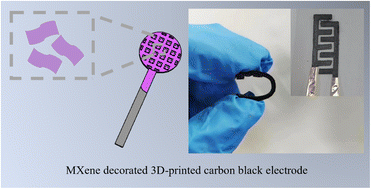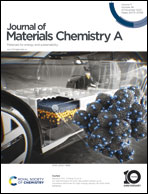MXene decorated 3D-printed carbon black-based electrodes for solid-state micro-supercapacitors†
Abstract
Three-dimensional (3D) printing offers a unique approach to fabricating free-standing and complex structured electrodes for high-performance micro-supercapacitors (MSCs). Among the different 3D-printing techniques, fused deposition modeling (FDM) is a promising technique for upscaling due to its low price and maturity in industry. Herein, a conductive carbon black-based 3D-printable filament is designed to be used as a free-standing electrode after FDM printing, solvent activation, and MXene coating. The MXene layers could provide higher capacitances due to the pseudocapacitive charge storage mechanism and high metallic conductivity. In a three-electrode test system, the MXene decorated 3D-printed electrode (MXene@PTC-12 h) shows a capacitance of 30.2 mF cm−2 at a current density of 0.1 mA cm−2. With polyvinyl alcohol (PVA)/H2SO4 gel electrolyte, the MSCs based on the 3D printed electrodes provide a specific capacitance of 20.8 mF cm−2 at a current density of 0.1 mA cm−2 and a stable cycle life with 95% capacitance retention after 10 000 cycles. The method in this work offers a new way to prepare customized free-standing electrodes for high-performance energy storage devices.

- This article is part of the themed collection: 2023 Journal of Materials Chemistry A HOT Papers


 Please wait while we load your content...
Please wait while we load your content...